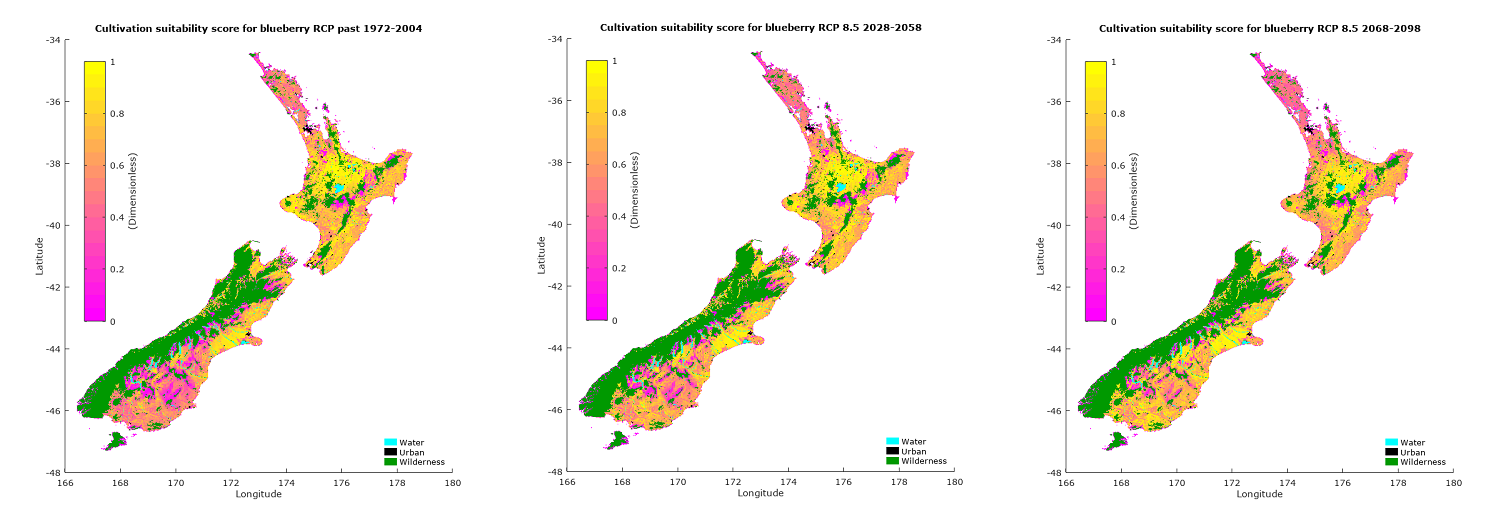Description
Suitability is based on consideration of multiple suitability criteria, and expressed as a score from 0 (totally unsuitable) to 1 (perfectly suited with no limitations with respect to any criteria).
The six-model ensemble suitability scores are provided for:
- the historical baseline (1971-2005),
- mid-century (2028-2058) and
- end of century (2068-2098)
for four Representive Concentration Pathways (RCP) of future anthropogenic emissions.
The soil-related criterai are derived from S-MAP and the fundamental soil layers.
Date: May 2023 Version: v1
Owner: PFR
Contact: Kumar Vetharaniam (Plant & Food Research)
Link to report / paper
Vetharaniam I, Müller K, Stanley J, van den Dijssel C, Timar L, Cummins M. April 2021. Modelling the effect of climate change on land suitability for growing perennial crops. A Plant & Food Research report prepared for: Ministry for Primary Industries. Milestone No. 87023 & 73685. Contract No. 34671. Job code: P/405421/01. PFR SPTS No. 20712.
Preview Image

Dataset attributes
| Spatial extent |
New Zealand |
|---|
| Spatial resolution |
NIWA Virtual Climate Station Network 5km climate grid
S-map / FSL sampled on a 1 by 1 km grid |
|---|
| Temporal extent |
30 year normal: past, mid century and end of century |
|---|
| Temporal resolution |
Annual and seasonal climatologies |
|---|
| Evaluation method (Validation) |
N/A |
|---|
| Evaluation result (Numeric) |
N/A |
|---|
| Evaluation result (Categorical) |
N/A |
|---|
| Uncertainty method |
This dataset consists of six-model ensemble and multiple RCPs. Further analysis to assess the uncertainty is not yet attempted. |
|---|
| Uncertainty data format (Numeric) |
None |
|---|
| Uncertainty data format (Categorical) |
None |
|---|
Methodology
Estimated production for average Southern Highbush cultivars with a chill requirement of 550 hours < 7°C and a GDD requirement of 700 d°C base 10°C.
Suitability criteria are related to:
i) risk of damage to canes and vines from extreme cold,
ii) sufficiency of warmth during the growing season (growing degree days),
iii) risk of frost damage to flowers and fruit,
iv) sufficiency of winter chill for flowering,
v) soil drainage,
vi) potential rooting depth,
vii) land use capability class,
viii) slope of land.
It was assumed that irrigation would be used when required, and thus rainfall was not considered as a criterion.
Suitability scores for climate-related criteria were calculated separately for each year and averaged to get a yearly climate score using weighted geometric means, with weights reflecting the relative importance of criteria. Yearly climate scores were averaged using arithmetic means to get an overall climate score. Suitability scores for land-related criteria were calculated separately and averaged using weighted geometric means to get an overall land suitability score. Climate and land suitability scores were averaged by taking their weighted geometric mean to obtain an overall location suitability score. Overall scores were averaged for each RCP and each past or future period.
Factsheet: Climate change impacts on blueberry
Main report: Modelling the effect of climate change on land suitability for growing perennial crops
Fitness for purpose / limitations
This table indicates whether the dataset is suitable for different types of questions at different scales.
Note: Users should carefully consider their purpose as this dataset may not be suitable.
|
Operational
| Absolute
| Relative
| Screening/scoping
|
| Block/farm |
No | No | Maybe | Maybe |
| Multi-farms(5+) |
No | No | Yes | Yes |
| Catchment |
No | No | Yes | Yes |
| National/regional |
No | No | Yes | Yes |
Caveat(s) |
Does not include micro climate. Climate change projections are very uncertain. |
